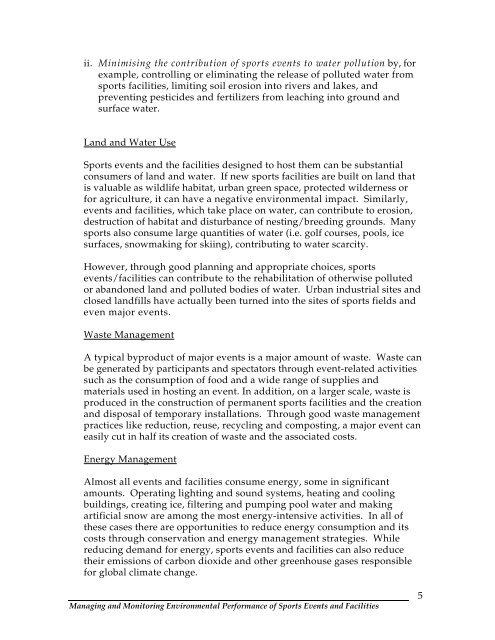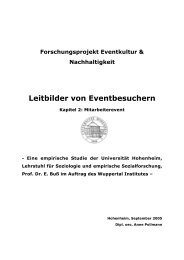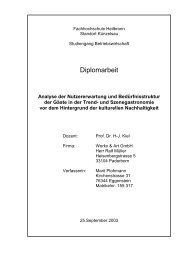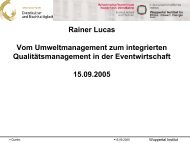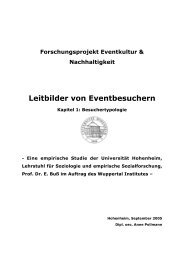environmental management and monitoring for ... - Eventkultur.lab
environmental management and monitoring for ... - Eventkultur.lab
environmental management and monitoring for ... - Eventkultur.lab
You also want an ePaper? Increase the reach of your titles
YUMPU automatically turns print PDFs into web optimized ePapers that Google loves.
ii. Minimising the contribution of sports events to water pollution by, <strong>for</strong><br />
example, controlling or eliminating the release of polluted water from<br />
sports facilities, limiting soil erosion into rivers <strong>and</strong> lakes, <strong>and</strong><br />
preventing pesticides <strong>and</strong> fertilizers from leaching into ground <strong>and</strong><br />
surface water.<br />
L<strong>and</strong> <strong>and</strong> Water Use<br />
Sports events <strong>and</strong> the facilities designed to host them can be substantial<br />
consumers of l<strong>and</strong> <strong>and</strong> water. If new sports facilities are built on l<strong>and</strong> that<br />
is valuable as wildlife habitat, urban green space, protected wilderness or<br />
<strong>for</strong> agriculture, it can have a negative <strong>environmental</strong> impact. Similarly,<br />
events <strong>and</strong> facilities, which take place on water, can contribute to erosion,<br />
destruction of habitat <strong>and</strong> disturbance of nesting/breeding grounds. Many<br />
sports also consume large quantities of water (i.e. golf courses, pools, ice<br />
surfaces, snowmaking <strong>for</strong> skiing), contributing to water scarcity.<br />
However, through good planning <strong>and</strong> appropriate choices, sports<br />
events/facilities can contribute to the rehabilitation of otherwise polluted<br />
or ab<strong>and</strong>oned l<strong>and</strong> <strong>and</strong> polluted bodies of water. Urban industrial sites <strong>and</strong><br />
closed l<strong>and</strong>fills have actually been turned into the sites of sports fields <strong>and</strong><br />
even major events.<br />
Waste Management<br />
A typical byproduct of major events is a major amount of waste. Waste can<br />
be generated by participants <strong>and</strong> spectators through event-related activities<br />
such as the consumption of food <strong>and</strong> a wide range of supplies <strong>and</strong><br />
materials used in hosting an event. In addition, on a larger scale, waste is<br />
produced in the construction of permanent sports facilities <strong>and</strong> the creation<br />
<strong>and</strong> disposal of temporary installations. Through good waste <strong>management</strong><br />
practices like reduction, reuse, recycling <strong>and</strong> composting, a major event can<br />
easily cut in half its creation of waste <strong>and</strong> the associated costs.<br />
Energy Management<br />
Almost all events <strong>and</strong> facilities consume energy, some in significant<br />
amounts. Operating lighting <strong>and</strong> sound systems, heating <strong>and</strong> cooling<br />
buildings, creating ice, filtering <strong>and</strong> pumping pool water <strong>and</strong> making<br />
artificial snow are among the most energy-intensive activities. In all of<br />
these cases there are opportunities to reduce energy consumption <strong>and</strong> its<br />
costs through conservation <strong>and</strong> energy <strong>management</strong> strategies. While<br />
reducing dem<strong>and</strong> <strong>for</strong> energy, sports events <strong>and</strong> facilities can also reduce<br />
their emissions of carbon dioxide <strong>and</strong> other greenhouse gases responsible<br />
<strong>for</strong> global climate change.<br />
Managing <strong>and</strong> Monitoring Environmental Per<strong>for</strong>mance of Sports Events <strong>and</strong> Facilities<br />
5


